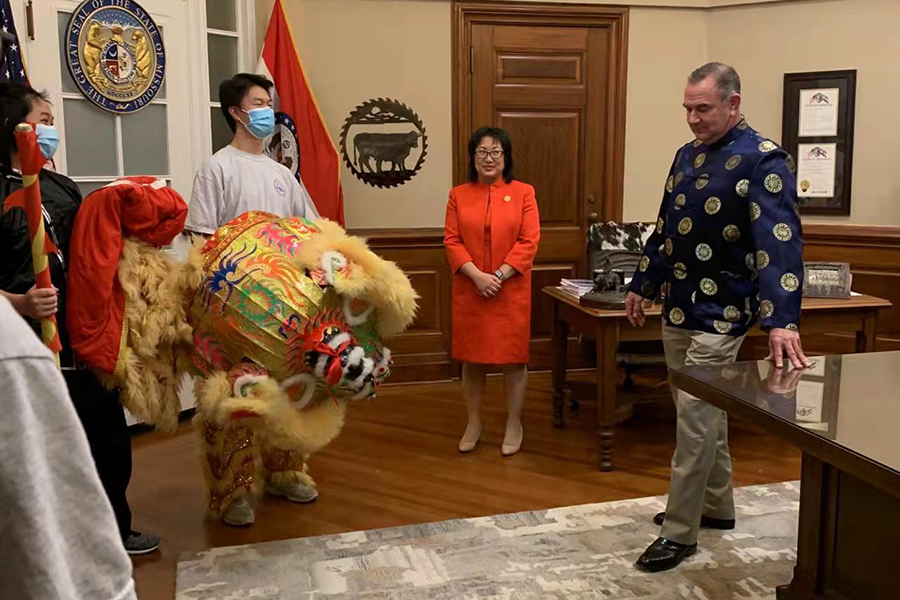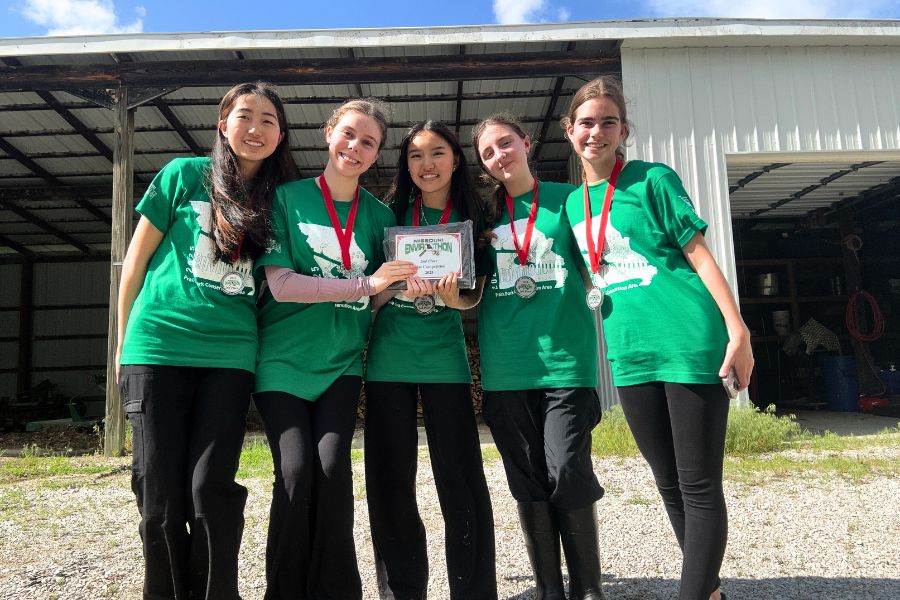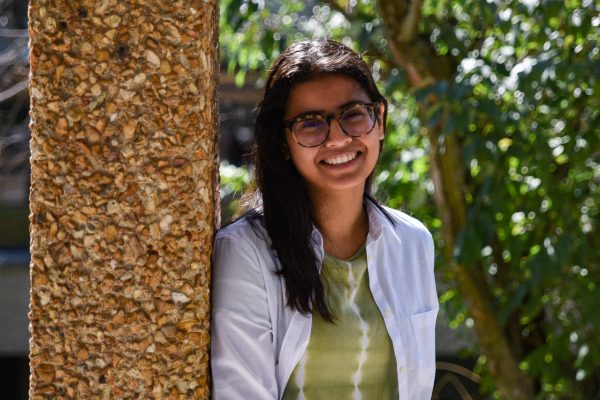The tanggu, a Chinese drum, beats in rhythm with the red and gold dancing lion while the eager crowd parades along excitedly. The onlookers smile with warmth underneath their masks, celebrating the arrival of spring, new beginnings and a year filled with good luck and fortune. At the end of the performance, the huge lion head lifts to reveal junior Ryan Feng.
As a member of the Chinese community in St. Louis, junior Ryan Feng takes part in Lunar New Year celebrations and performances. Feng is the captain of a 12-person lion dancing team at the St. Louis Chinese Language School.
“I manage the head of the lion, being the captain, while my other teammates manage the tail and the body of the lion. It can be difficult to coordinate everybody to be on the same page and doing the same thing because when you’re performing, everything has to be synchronized; that’s how it looks good,” Feng says. “While the costumes are pretty colorful and fun, they are really heavy, making them burdensome to carry, especially because you are on the inside and jumping, kicking, rolling. But seeing people’s reactions, seeing the little kids smiling and enjoying our performances, makes all the hard work worth it.”
Feng’s team performs at various venues throughout the state nearing the Lunar New Year, their main event being on Chinese Cultural Days at the Botanical Garden. They also perform at the governor’s mansion in Jefferson City, and on Feb. 5, the team will perform at a retirement home, Friendship Village at Sunset Hills. Feng first joined the team when he was a freshman in high school.
“Once I joined the Chinese school, I saw there was a lion dancing team. Immediately I wanted to be a part of it because I wanted to connect with my roots. From then on, the upperclassmen just trained me,” Feng said. “ I’ve met a lot of people and been to a lot of cultural events that really opened my eyes as to what my Chinese culture entailed, but other than that, it’s just been a lot of fun. I love spending my time doing it. And I’ve moved up through the ranks, I’m a captain now, so it’s enjoyable just being with my Asian friends and performing.”
Last year, because of COVID-19, Feng’s lion dancing group was only able to perform once at the Botanical Garden. Now, masks are only encouraged for the audience and for the performers when they are not dancing.
“One of the biggest indirect things COVID-19 has done is that we weren’t able to get new team members. Now that those old team members have graduated, it’s kind of hard coordinating everything with new members,” Feng said.
Though COVID-19 has changed aspects of the celebrations, the performances and celebrations still have symbolic values embedded in them. For example, each new Lunar year in the Chinese calendar is associated with one of the 12 zodiac animals. This year is the year of the tiger, symbolizing courage, ambition and taking risks. It is deemed to be the greatest earthly power.
“One of the things we’re doing in our performances is that we wave a ball around at the lions and we show the ball to the other lion. Then they both jump back and forth to try to catch the ball,” Feng said. “Basically, that is the symbolism for waking up the spirits of prosperity. When we catch the ball with the lion’s head, that is another symbolic representation of wealth and health prosperity.”
Asian culture is widespread in our nation, with China being the second leading country of origin for immigrants. However, in Feng’s personal experience, many Americans misunderstand aspects of his culture.
“Growing up, in a 100 percent Asian household, a culture different from everyone else’s at school, I felt some sort of disparity. Going to an American public school, you don’t really learn a lot about Chinese traditional culture or even Asian holidays,” Feng said. “If we really want to raise awareness about Chinese culture, we should probably be talking about, or at least addressing it in a school environment. It would definitely make me feel more included and part of the community.”
Lunar New Year Zodiac by Audrey Ghosh



![Focused on providing exceptional service, sophomore Darsh Mahapatra carefully cleans the door of a customer’s car. Mahapatra has always believed his customers deserve nothing less than the best. “[If] they’re trusting us with their car and our service, then I am convinced that they deserve our 100 percent effort and beyond,” Mahapatra said.](https://pwestpathfinder.com/wp-content/uploads/2025/10/DSC_0018-1200x800.jpg)
![Sophomore Aleix Pi de Cabanyes Navarro (left) finishes up a soccer game while junior Ava Muench (right) warms up for cross country practice. The two came to Parkway West High School as exchange students for the 2025-2026 school year. “The goal for the [exchange] program is to provide opportunities for both Parkway students and our international exchange students to learn about other cultures, build connections and become confident, capable, curious and caring — Parkway’s Four C’s — in the process,” Exchange Program Lead Lauren Farrelly said.](https://pwestpathfinder.com/wp-content/uploads/2025/10/Feature-Photo-1200x800.png)

![Gazing across the stage, sophomore Alexis Monteleone performs in the school theater. The Monteleone family’s band “Monte and the Machine” has been releasing music since 2012, but Alexis started her own solo career in 2024 with the release of her first single, Crying Skies. “My whole family is very musical, [and I especially] love writing [songs with them],” Monteleone said.](https://pwestpathfinder.com/wp-content/uploads/2025/09/DSC7463-1200x798.jpg)
![Amid teaching a lesson to her AP Calculus BC class, Kristin Judd jokes alongside her students in their funny remarks. Judd has always enjoyed keeping the mood light in her classroom, along with on the volleyball court. “[I enjoy] that side talk where you see [or] overhear a conversation and chime in, or somebody says something funny,” Judd said.](https://pwestpathfinder.com/wp-content/uploads/2025/09/image-1200x730.jpg)
![Eyeing the ball, junior Ella McNeal poses for her commitment pictures at Clemson University. McNeal’s commitment comes after months of contact with top Division 1 soccer programs. “ It has taken a lot to get to where I am, but I know that [what] I've already been through is just the beginning, and I can't wait for what is to come,” McNeal said.](https://pwestpathfinder.com/wp-content/uploads/2025/09/IMG_4926-1200x900.jpeg)


![Senior Adam Zerega stands with senior Dexter Brooks by farm equipment. Zerega often worked with friends and family on his farm. “I've been able to go to my family's farm since I was born. I [spend] at least three weekends a month [on the farm], so I'm there all the time,” Zerega said.](https://pwestpathfinder.com/wp-content/uploads/2025/04/IMG_4872-1200x900.jpg)

![After a thrilling point, senior Katie Byergo and junior Elle Lanferseick high-five each other on Oct. 8. With teamwork and camaraderie, Byergo worked together in the game against Lafayette High School. “[Byergo’s] is really positive with a good spirit,” Lanferseick said. “I set her [the ball] and she hits it [or] gets the kill.”](https://pwestpathfinder.com/wp-content/uploads/2025/10/DSC_9349-1-e1761159125735-1200x791.jpg)
![Leaning on the podium, superintendent Melissa Schneider speaks to Parkway journalism students during a press conference. Schneider joined Parkway in July after working in the Thompson School District in Colorado. “My plan [to bond with students] is to get things on my calendar as much as possible. For example, being in [classes] is very special to me. I am trying to be opportunistic [meeting] kids [and] being in [the school] buildings. I have all the sports schedules and the fine arts schedules on my calendar, so that when I'm available, I can get to them,” Schneider said.](https://pwestpathfinder.com/wp-content/uploads/2025/09/IMG_5425-1200x943.jpeg)

![Leaping through the air, senior Tyler Watts celebrates his first goal of the season, which put the Longhorns up 1-0 against the Lafayette Lancers. Watts decided to play soccer for West for his last year of high school and secured a spot on the varsity roster. “[Playing soccer for West] is something I had always dreamed of, but hadn’t really had a good opportunity to do until now. It’s [really] fun being out [on the field], and I’m glad I decided to join the team. It’s just all about having fun with the boys and enjoying what time we have left together,” Watts said.](https://pwestpathfinder.com/wp-content/uploads/2025/09/DSC_1951-1200x855.jpg)

![Shifting global trade, President Donald Trump’s tariffs are raising concerns about economic stability for the U.S. and other countries alike. “[The tariffs are] going to pose a distinct challenge to the U.S. economy and a challenge to the global economy on the whole because it's going to greatly upset who trades with who and where resources and products are going to come from,” social studies teacher Melvin Trotier said.](https://pwestpathfinder.com/wp-content/uploads/2025/05/MDB_3456-1200x800.jpg)

![Pitching the ball on Apr. 14, senior Henry Wild and his team play against Belleville East. Wild was named scholar athlete of the year by St. Louis Post-Dispatch after maintaining a high cumulative GPA and staying involved with athletics for all of high school. “It’s an amazing honor. I feel very blessed to have the opportunity to represent my school [and] what [it] stands for,” Wild said.](https://pwestpathfinder.com/wp-content/uploads/2025/05/unnamed-6-1200x714.jpg)
![Red, white and blue, the American flag holds the values of our democracy. The fight that we once endured has returned, as student journalists and senior correspondents across the country are losing their voices due to government control. “[Are] the White House and [the] government limiting free speech [and] freedom of the press? Yes [they are],” chief communications officer of the Parkway School District and former journalist Elisa Tomich said.](https://pwestpathfinder.com/wp-content/uploads/2025/03/Untitled-design-14.jpg)
![Freezing in their position, the Addams Family cast hits the “rigor mortis” pose after cast member and senior Jack Mullen, in character as Gomez Addams, calls out the stiff death move. For the past four months, the combined company of cast members, orchestra pit, crew and directors all worked to create the familial chemistry of the show. “I’m excited for [the audience] to see the numbers, the music, the scenes, but I also just love all the technical aspects of it. The whole spectacle, the costumes, makeup and the people that put in the work backstage in order to make the show successful on stage. I’m excited for people to see and appreciate that,” Mullen said.](https://pwestpathfinder.com/wp-content/uploads/2025/03/DSC0116-1200x800.jpg)
